As climate change takes hold the UK is facing a growing pressure from flooding, with major impacts on communities downstream from moorlands. This brings with it a huge cost to individuals, businesses and the economy in those areas which suffer from major and repeated flood events.
Our uplands play a crucial role in mitigating flood risks by slowing down the flow of water cascading from the hills and providing sustainable water storage at a landscape scale. By adopting a variety of sustainable land management practices, we can make a substantial difference towards utilitising the power of nature to protect people and communities from flooding.
Restoring peatland ecosystems is a pivotal strategy in reducing flood risk. This involves blocking gullies, revegetating exposed areas, and putting an end to harmful practices. These efforts rejuvenate habitats, turning them into natural flood barriers for downstream communities. Specialist vegetation like sponge-like sphagnum moss is a game-changer, capable of absorbing up to 20 times its weight in water.

When peatland is in good health, it creates an ecosystem that ensures an increased lag time and reduced peak flow of runoff water. This means water is released downstream over a more extended period, reducing the likelihood of flood events.
Another important natural flood management technique is tree planting and natural regeneration of trees. This process often involves the strategic planting of native trees such as rowan, oak, and birch or allowing trees to self-seed. This kickstart swoodland rejuvenation on moorland slopes and in cloughs to help create vibrant, natural woodlands. These woodlands act as a natural buffer, absorbing excess water and reducing the risk of flooding downstream.
By actively participating in the restoration of our uplands, we can be the change needed to safeguard our communities from flooding and create resilient landscapes for future generations. Together, we have the power to make a difference, ensuring the preservation of our precious natural heritage.